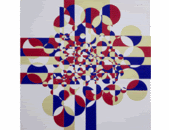Marian Goodman Gallery
24 West 57th Street
Gabriel Orozco
October 6th – November 12, 2005
A quote from the Gabriel Orozco press release provided by Marian Goodman Gallery reads as follows:
A related video work, 677 Variants (2005, 11 min. Color) created by computer-generated animation and shown on a flat screen, will be on view in an adjacent gallery. Based on the formal vocabulary of geometric patterns and colors used in the diagrams for the paintings, 677 Variants articulates the motion of spheres, cells, atoms, voids, and ellipses intrinsic to Orozco’s iconography, from the airline ticket drawings to the Atomists series, mediating on an entire morphology of representation.
The above is an excellent example of writing that does little but alienate a larger art audience. It basically describes the effect of animation on still works, but reading this, you’d think that the Orozco video had also contributed significant findings to the molecular biologist community. In addition, the release tells us that the piece contemplates the form and structure of representation, a point the more sophisticated art viewer may be able to discern, but a general art viewing audience, which includes countless collectors, probably do not have a lexicon large enough to grasp all this immediately.
Now, there is little reason to write this way, unless, you are, say, compensating for what isn’t there in the first place. So, let me spell out what this press release does not say: The Orozco show at Marian Goodman was not good. You wouldn’t know it from the press release you just read, but below is a rough approximation of the video it describes.

So basically, what animation above shows us is that Orozco has figured out how to use imovie. There’s no point going into what makes this piece so profoundly stupid, since there are more interesting things to discuss in the show, but, put shortly the movie is a gimicky addition to a body of work which does nothing but repeat 40 years modernist exploration. Orozco, of course has loftier ideas for this work, and frankly ends up sounding a little egocentric when he talks about them:
I decided to do the paintings to see how much they could express geometry but also organicity…I decided to start from the center of the plane, which I think is not very common…The sequence of colors is distributed based on how the chess knight moves, “jumping” two blocks and one, which I take as presentation of tri-dimensionality in a bi-dimensional field”
Gabriel Orozco Excerpt from the Marian Goodman Gallery press release, 2005.
Certainly, it is not unheard of to start a painting from the center of the canvas, so you’ll forgive me Mr. Orozco, if I don’t think that this practice is particularly ground breaking. What’s more, as far as I know, “tri-dimensionality in a bi-dimensional field”, is a term typically applied to holography. The paintings shown at Goodman have very flat surfaces, and the use of gold alone, is not enough to transform these works into something tri-dimensional.
There is more to the exhibition though then these paintings, since there is an entire room devoted to other work. Deceptively large, the most interesting part of the show was in the back gallery, and consisted primarily of a table top display of objects and various ephemera made by the artist over the last five years. Admittedly, this section of the exhibition is a little like listening to a re-released U2 b-side, in that it’s clearly not his best stuff, but given the current work, it is a welcome break. There are one or two good photos, and a few objects that hold some resonance, such as a pizza placed under a round shaped wire kitchen utensil of similar size, and a various clay sculptures which are designed to be hand held, but little past this. To be fair, there are probably more than “a few” objects in the show that are exceptional, but as galleries are some times want to do, (since you can’t sell what you can’t see) there was too much art displayed to really be able to tell the good from the bad. With this type of work, you cannot be too careful when considering the possiblity of over populating a display, since it very quickly begins to look like a yard sale.
The curating of the show however, is a digression, because it ultimately is a small point that neither breaks or makes the show. What makes the exhibition such a disappointment is that, with only a few exceptions, it is lacking the substance that has made Orozco’s work so powerful in the past. The best of his art presents polarity, multiplicity and complex philosophical ideas within small moments and humble gestures. Pinched Ball, Common Dream, and Ten Pesos, are not only among is strongest works, but the influence works such as these have had on emerging artist’s, in particular Latin American community, is striking. Artists such as Jose Lerma, (paintings excluded) Gustavo Artigas, and Teresa Margolles are all making work that follows a tradition established by artists like Gabriel Orozco, Felix Gonzalez -Torres and others, and it is among the more engaging work being made today by emerging artists. As seen in this light, it is easy to make a compelling argument that Orozco is one of a small number of artists whose work will be seen to have had a profound effect on the shape of contemporary art in the future. That is, assuming you disregard the year 2005 in the artist’s career.
***The influence and strength of Orozco’s earlier work may explain the glowing review Holland Cotter gave the show in the New York Times on the 11th. I suppose we can’t all be exempt from wearing blinders from time to time.


Comments on this entry are closed.